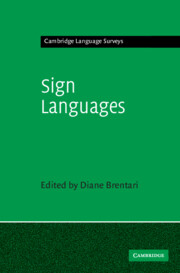Book contents
- Frontmatter
- Contents
- List of figures
- List of tables
- List of contributors
- List of sign language abbreviations
- Notational conventions
- 1 Introduction
- I HISTORY AND TRANSMISSION
- II SHARED CROSSLINGUISTIC CHARACTERISTICS
- III VARIATION AND CHANGE
- 18 Sign languages in West Africa
- 19 Sign languages in the Arab world
- 20 Variation in American Sign Language
- 21 Sociolinguistic variation in British, Australian and New Zealand Sign Languages
- 22 Variation in East Asian sign language structures
- 23 Crosslinguistic variation in prosodic cues
- 24 Deixis in an emerging sign language
- 25 The grammar of space in two new sign languages
- Notes
- References
- Index
19 - Sign languages in the Arab world
from III - VARIATION AND CHANGE
Published online by Cambridge University Press: 05 June 2012
- Frontmatter
- Contents
- List of figures
- List of tables
- List of contributors
- List of sign language abbreviations
- Notational conventions
- 1 Introduction
- I HISTORY AND TRANSMISSION
- II SHARED CROSSLINGUISTIC CHARACTERISTICS
- III VARIATION AND CHANGE
- 18 Sign languages in West Africa
- 19 Sign languages in the Arab world
- 20 Variation in American Sign Language
- 21 Sociolinguistic variation in British, Australian and New Zealand Sign Languages
- 22 Variation in East Asian sign language structures
- 23 Crosslinguistic variation in prosodic cues
- 24 Deixis in an emerging sign language
- 25 The grammar of space in two new sign languages
- Notes
- References
- Index
Summary
Introduction
Every evening, the Al Jazeera satellite channel features a one-hour, comprehensive newscast of world events. Superimposed in the corner of the television screen is a box containing a sign language interpreter who translates the spoken Arabic of the newscaster. The interpreter is one of a team of Jordanian Sign Language (LIU) interpreters who regularly interpret the newscast. However, the sign language they use is not strictly LIU. Heavily influenced by LIU, it is a newly devised sign language which uses vocabulary drawn from different Arab sign languages, including Egyptian Sign Language and Saudi Sign Language. The vocabulary was compiled in a dictionary by the Council of Arab Ministers of Social Affairs (CAMSA), a committee within the League of Arab States (LAS).
The effort by CAMSA to encourage a standard pan-Arab Sign Language (ArSL) has been met with wide resistance, in large part because deaf viewers say they cannot understand the language. In this paper, we describe the geography of sign languages in Arab countries. As we explain, there already exists a number of sign languages used by Arab deaf communities. Some are designated as nation-state sign languages and are used in the instruction of deaf students in their educational systems. The adoption of ArSL by Arab countries potentially threatens the future of these nation-state sign languages as well as an unknown number of smaller sign languages existing within this region.
- Type
- Chapter
- Information
- Sign Languages , pp. 433 - 450Publisher: Cambridge University PressPrint publication year: 2010
- 27
- Cited by

